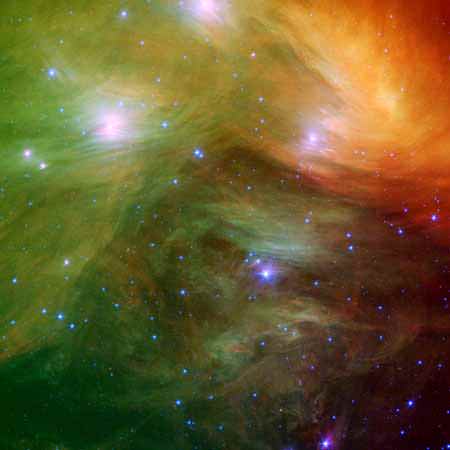Are you ready for another Where In The Universe Challenge? Take a look at the image above and see if you can name where in the Universe this image is from. Give yourself extra points if you can name the spacecraft responsible for the image. We’ll provide the image today, but won’t reveal the answer until tomorrow. This gives you a chance to mull over the image and provide your answer/guess in the comment section. Check back tomorrow on this same post to see how you did. Good luck!
UPDATE: The answer has now been posted below. Don’t peek before you make your guess!
This is an image of the Pleiades star cluster, also known as the Seven Sisters, taken by the Spitzer Space Telescope. The Pleiades, located more than 400 light-years away in the Taurus constellation, are the subject of many legends and writings. Greek mythology holds that the flock of stars was transformed into celestial doves by Zeus to save them from a pursuant Orion. The 19th-century poet Alfred Lord Tennyson described them as “glittering like a swarm of fireflies tangled in a silver braid.”
This image from Spitzer highlights the “tangled silver braid.” The spider-web-like network of filaments, colored yellow, green and red in this view, is made up of dust associated with the cloud through which the cluster is traveling. The densest portion of the cloud appears in yellow and red, and the more diffuse outskirts are shown in green hues. One of the parent stars, Atlas, can be seen at the bottom, while six of the sisters are visible at top. Additional stars in the cluster are sprinkled throughout the picture in blue.
How did you do? Come back again next week for another WITU Challenge.


Looks like the Pleiades… Spitzer.
Complete guess though.
Rho Ophiuchi
Total guess here: a detail somewhere in the Orion molecular cloud. Spacecraft? Hubble perhaps. Or Spitzer.
It’s the Merope Nebula (NGC 1435) in the Pleiades star cluster, taken by the Spitzer space telescope.
My guess is a nebula somewhere.. but I have no idea what it is or what took it. 🙂
The Merope Nebula (also known as Tempel’s Nebula, or NGC 1435)in the Pleiades star cluster, surrounding the star Merope.
This might spoil some people’s fun, but if you click on the picture you will get a full article detailing the answer…
it might be the inner of Orion by Spitzer, i think
I think it is the Pleiades star by Hubble and Spitzer!!!
Nancy!! Maybe you shd do something to the link that comes when you click the image!!!
If you want a real challenge, you should delete the exif data of the picture. So there’s no fun.
It’s the Merope Nebula (NGC 1435) in the Pleiades star cluster. The spacecraft from which the image was taken is the Spitzer telescope.
Thanks for the heads up, everyone. I have no idea how that happened. I think WordPress is conspiring to give away my secrets!
Orion nebula
Its M45 – Pleiads by Spitzer
Barnes Museum just outside Philadelphia.
That’s clearly a Renoir!
That’s his favorite red headed model.
Well, it might be the Pleiades but I think Mike Lynch is right.
As I said before, this answer wasn’t only available through the link on the pic, it was also in the exif-data of the picture after the removing of the link.
You only have to do a right-click on the pic and look at the image properties.
Bild-Orientierung: 1
Datum der Aufnahme: 2007:04:11 15:28:52
Bildbeschreibung: The Seven Sisters, also known as the Pleiades, seem to float on a bed of feathers in a new infrared image from NASA’s Spitzer Space Telescope. Clouds of dust sweep around the stars, swaddling them in a cushiony veil.
The Pleiades, located more than 400 light-years away in the Taurus constellation, are the subject of many legends and writings. Greek mythology holds that the flock of stars was transformed into celestial doves by Zeus to save them from a pursuant Orion. The 19th-century poet Alfred Lord Tennyson described them as “glittering like a swarm of fireflies tangled in a silver braid.”
The star cluster was born when dinosaurs still roamed the Earth, about one hundred million years ago. It is significantly younger than our 5-billion-year-old sun. The brightest members of the cluster, also the highest-mass stars, are known in Greek mythology as two parents, Atlas and Pleione, and their seven daughters, Alcyone, Electra, Maia, Merope, Taygeta, Celaeno and Asterope. There are thousands of additional lower-mass members, including many stars like our sun. Some scientists believe that our sun grew up in a crowded region like the Pleiades, before migrating to its present, more isolated home.
The new infrared image from Spitzer highlights the “tangled silver braid” mentioned in the poem by Tennyson. This spider-web like network of filaments, colored yellow, green and red in this view, is made up of dust associated with the cloud through which the cluster is traveling. The densest portion of the cloud appears in yellow and red, and the more diffuse outskirts appear in green hues. One of the parent stars, Atlas, can be seen at the bottom, while six of the sisters are visible at top.
The Spitzer data also reveals never-before-seen brown dwarfs, or “failed stars,” and disks of planetary debris (not pictured). John Stauffer of NASA’s Spitzer Space Telescope says Spitzer’s infrared vision allows astronomers to better study the cooler, lower-mass stars in the region, which are much fainter when viewed in optical light. Stauffer, who admits to being biased because the Pleiades is his favorite astronomical object, says the cluster is the perfect laboratory for understanding the evolution of stars.
Benutzte Software: Adobe Photoshop CS3 Macintosh
Erstellt hat das Bild: Spitzer Space Telescope
Inhaber des Copyrights: http://www.spitzer.caltech.edu/Media/mediaimages/copyright.shtml